26.08.2022
Being Surface
Visual arts
Content warning: text & images contain elements of violence that might disturb sensitive audiences.
Publication Histories
The present text is a short version of the article originally published in Performance Philosophy Vol.7, №2 (2022):111–140 [DOI: https://doi.org/10.21476/PP.2022.72360, ISSN 2057–7176], based on the author’s practice-led Ph.D. Thesis in Philosophy & Fine Art (Performance) at the Royal College of Art in London, supervised by Prof. Johnny Golding (Primary) & Prof. Nigel Rolfe (Second, 2015–2019), and supported by the Onassis Foundation Scholarship for Research studies (Scholarship ID: F ZL 027–1/2015–2016).
Introduction
The paper problematizes the ways in which performance art might be philosophy, and vice versa, that is; how philosophy might operate as embodied praxis and method. The performance practice under discussion stands as the research’s starting point, method and output, with all the works brought forward being conceived and performed by myself. However, the deliberate use of a third- person phrasing (e.g. ‘the performer’, ‘the artist’) while describing these performances serves as a strategic methodological choice of narration, so as to avoid oversentimentality, egocentrism, and a sense of diary/confession writing, even more so due to the already quite visceral character of the live works presented.
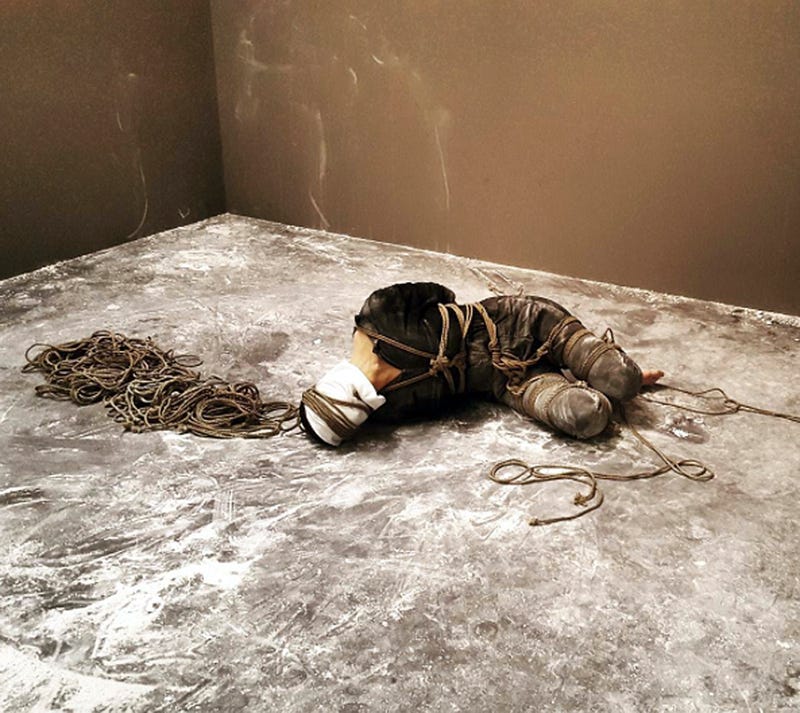
Performance as Philosophy / Philosophy as Embodied Practice
The main hypothesis adopted is based on the argument that philosophy, though predominantly thought of as a rational ideological construction, is essentially an invitation towards change and a method on how to lead one’s life (Hadot 2001, 148). This position has been particularly stressed by philosophers Pierre Hadot and Michel Foucault, who revisited ancient Greek philosophy to indicate how embodied practices might operate as methodologies for leading one’s life. Foucault, in the late years of his life, focused on the notion of parrhēsia (Greek term indicating a particular kind of courageous truth-telling) as practiced by the Cynics and early Christian ascetics (Foucault, 2011), in the context of his research on a new hermeneutics of the subject (Foucault 2005) that would comprise technologies of the body in the form of care of the self and others. It is in that respect that one should look at Foucault’s engagement with sadomasochistic practices; as a laboratory (Rabinow 2000, 151) for “the creation of new forms of life” (Rabinow 2000, 164).
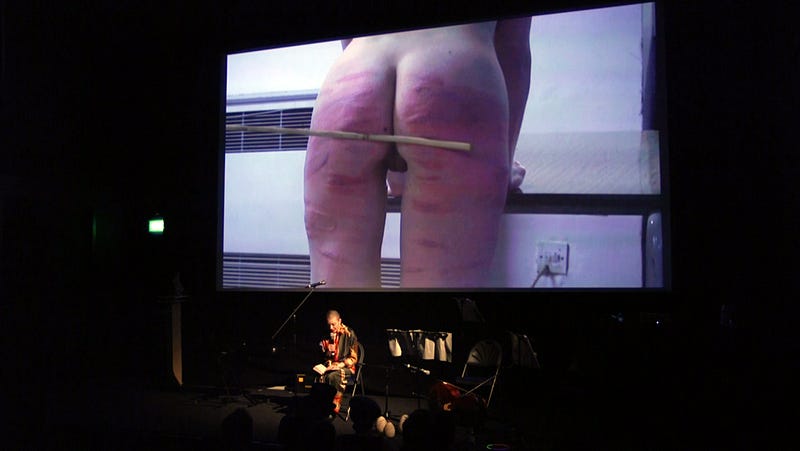
Violence as an Apparatus towards Performance-as-Surface / Life-as-Surface
In light of the above, this text discusses how performance strategies related to violence might suggest a radical re-thinking and revisiting of philosophy as embodied practice and method towards a life-as-surface, that is; a life experienced in its full intensity and in pure joy. Violence in the context of this research is defined as any force exercised among bodies at the moment of their encounter, with its effect having a severe impact on the bodies upon which it is applied. The way that violence operates in the live works put forward, differentiates itself from what seems to be at stake in existing examples in the field of performance art discourse, and brings to light alternative points of view than those already argued in the relevant bibliography (e.g. O’Dell 1998). On the contrary, violence is here rethought of as a technological apparatus for the generation and distribution of intensities within each live work, via the transmutation of the performer’s body into flesh, stripped of any given subjectivities. In so doing, the performance practice at stake, manages to operate as surface: as a field occupied only by intensities, thus also overlapping with Artaud and Deleuze and Guattari’s notion of the Body without Organs (Artaud 1988, 571; Deleuze and Guattari 2013, 177– 8). Therefore, the images created by the performer’s postures, movements and/or marks on the skin, would be but a manifestation of forces traversing the artist’s body at any given moment. In this way, the performer essentially takes the risk to reveal — while also protecting — a life which is radically other, a life affirmed as it is and as it is lived, without any ideological or moral presuppositions. Consequently, what is at stake in the works presented, would be contemporary performance art’s ability to operate as a locus of parrhēsia, and as an invitation to a new ethical life.
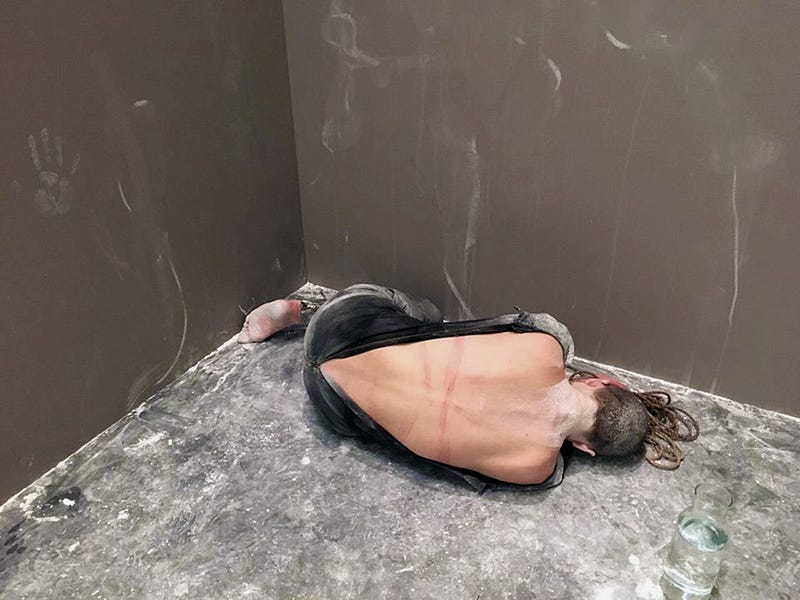
Works of violence
Following from violence’s definition as any force exercised among bodies at the moment of their encounter, with its effect having a severe impact on the bodies upon which it is applied, the works of violence brought forward could be distinguished into two categories: (a) performances in which violence takes place at a time prior to the performer’s appearance in front of an audience, and (b) works in which violence takes place during the ‘actual’ performance, either live or in a video format reproducing an action that has already happened in the past (during a performance piece or within a private consensual environment). In the first category (a), violence is presented either through marks left on the performer’s body as a trace/remainder, e.g.: bruises, imprints, and/or abrasions, or is implied through rituals of care that would constitute the ‘actual’ performance work, called upon to manage violence’s traumatic remainder.
Given the phrase ‘severe impact’ in the adopted definition of violence above, it would be necessary to investigate how this severe impact gets manifested in the performances discussed. In the following examples of works, this impact would be usually read via its residual expressions that constitute proof, testimony, and memory of the event of violence. Such residual expressions would include:
1. The intensities produced and distributed in the work, accompanied by the production of images of a body in spasm assuming positions and generating images that would be impossible to be engendered without the application of forces on the performer’s body and without the mediation of pain.
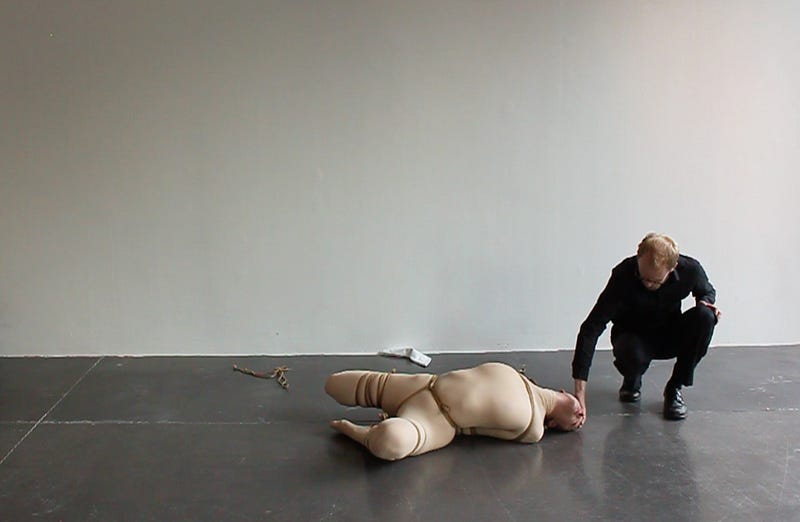
2. The creation of marks on the performer’s skin, such as: imprints, bruises, abrasions, or even breakings of the skin tissue (e.g. using body stapling), manifesting trauma-as-corporeal trace.
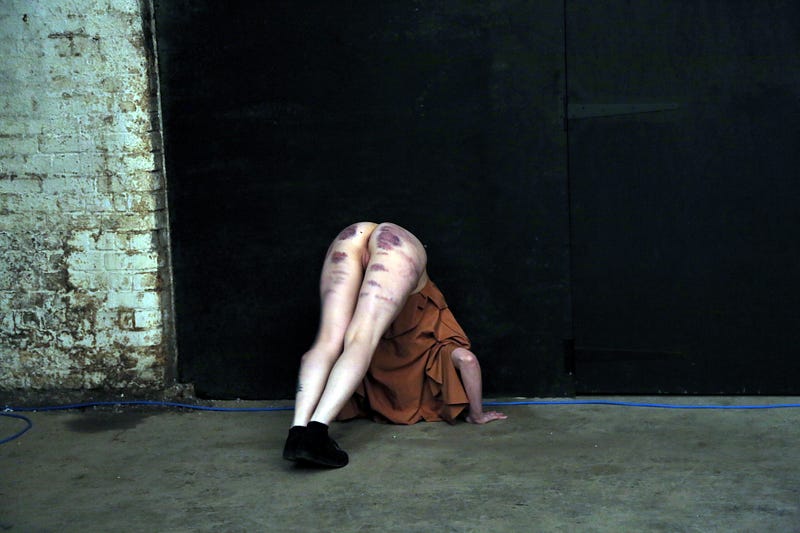
3. Rituals of care following the effects and affects of the violent forces exerted at a time prior to the performance work, including their residue-as-trauma.
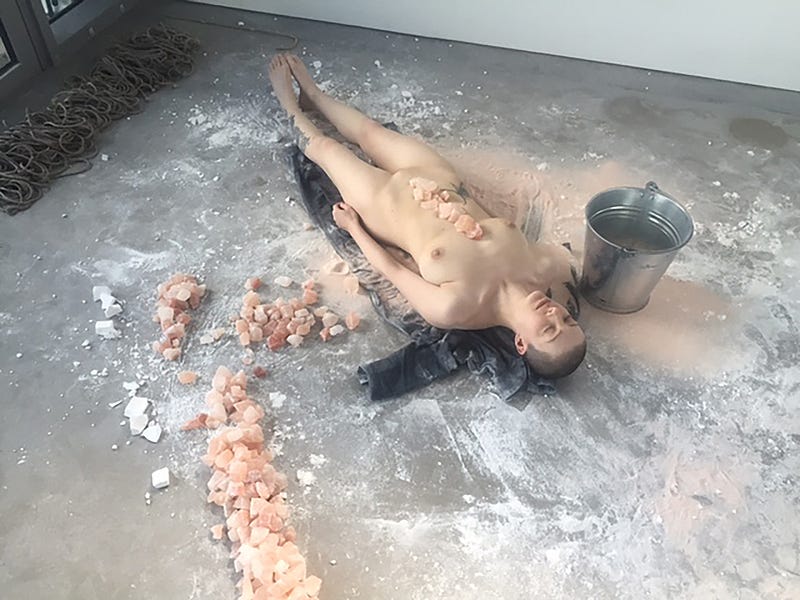
Vulnerability/Affectability
In the performances discussed, the testimony of a body submitted to violence during its encounter with other bodies, would indicate the ability of this body to affect and be affected by other bodies and forces. This ability would be named as affectability or vulnerability. Therefore, what is essentially at stake across this series of works of violence is the performer’s ability to exhibit a vulnerable and sensuous body affirming life as it is.
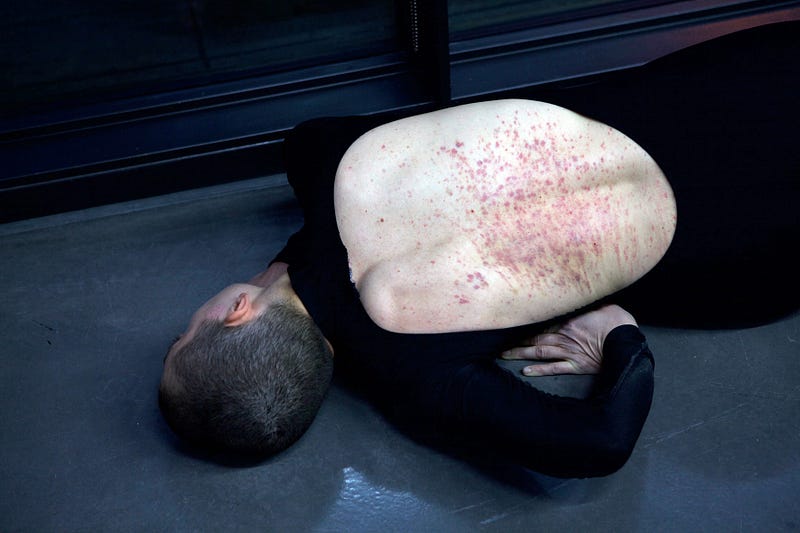
Towards a Politics of Intimacy & an Ethics of Care
To sum up, works of violence in my performance practice operate as fields occupied only by intensities where parrhēsiastic games take place to reveal life-as-surface, after shattering all essentialist categories and ideological hierarchies. Within this suggested condition of successive entanglements where bodies intra-act with other bodies, the possibility of a new ethics of care emerges. The following question, then, arises: are there any ethical limits within performance-as-surface and, consequently, life-as-surface? What would be the thickness and the porosity of those limits? After dismissing all kinds of morality, what is suggested instead would be the investigation of modes of conduct based on ideas of care; with care understood here as the maintenance of one’s ability to be useful. Given that one agrees with Agamben’s definition of intimacy as “use-of-oneself as relation with an inappropriable” (Agamben 2016, 91), then the performances brought forward would allow for intimate coherences to happen, not on the grounds of possession — and thus exchangeability — but on the uninterrupted circulation of forces via the use of the performer’s body, that would then be able to shapeshift across various fluid subjectivities, through use-of-oneself. In the suggested paradigm, therefore, care would not only be an ethical apparatus to safeguard the performer’s usefulness, but also a potential social contract for a new ethical life towards being surface.
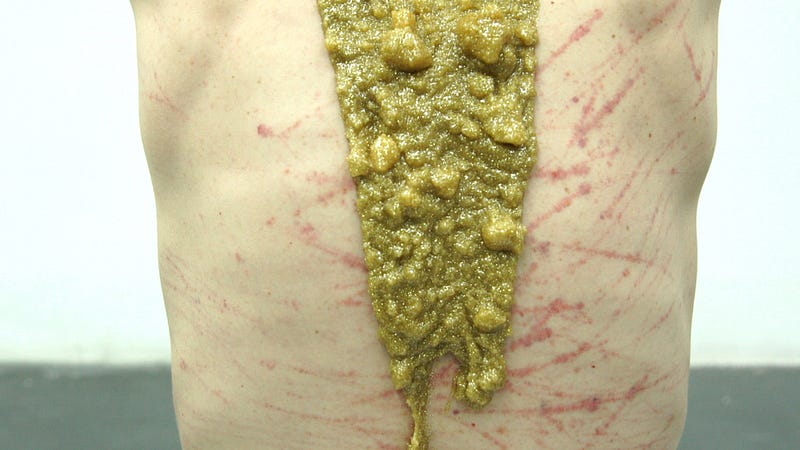
Links for performances discussed (links working at time of publication)
Corner Time (2016) https://mai.art/projects/asone despinazacharopoulou.com/corner-time
vimeo.com/197389133
Introduction (2015) despinazacharopoulou.com/introduction-hzztl
vimeo.com/147328308
Being a threat (2016) despinazacharopoulou.com/being-a-threat
vimeo.com/195880210
Aftercare Ι (2016) despinazacharopoulou.com/blank-1
Love *me* (2017) despinazacharopoulou.com/love-me
D’après S.K. (2017) despinazacharopoulou.com/d-apres-s-k vimeo.com/221403826
Aftercare IΙ (2016) despinazacharopoulou.com/blank-1
Surface (2017) despinazacharopoulou.com/surface-live-to-camera-ii
https://vimeo.com/249317661
Pudeur (d’après F.N.) (2017) despinazacharopoulou.com/pudeur-d-apres-f-n
vimeo.com/265869390
Pudeur II (d’après F.N.) (2018) despinazacharopoulou.com/pudeur-ii-d-apres-f-n
Aphorism (2019) despinazacharopoulou.com/aphorism
Response-ability (d’après K.B.) (2017) despinazacharopoulou.com/response-ability-d-apres-k-b
vimeo.com/249951756
General Bibliography
Abramović, Marina, with James Kaplan. 2016. Walk Through Walls: A Memoir. London: Penguin.
Agamben, Giorgio. 2016. The Use of Bodies. Translated by Adam Kotsko. Stanford: Stanford University Press.
Artaud, Antonin. 1988. Selected Writings. Translated by Helen Weaver. Berkeley: University of California Press.
Barad, Karen. 2007. Meeting the Universe Halfway: Quantum Physics and the Entanglement of Matter and Meaning. Durham, NC: Duke University Press. https://doi.org/10.2307/j.ctv12101zq
Bataille, Georges. 1985. Visions of Excess: Selected Writings, 1927–1939. Translated by Allan Stoekl with Carl
R. Lovitt and Donald N. Leslie, Jr. Minneapolis: University of Minnesota Press.
— — — . 2012. Eroticism. Translated by Mary Dalwood. London: Penguin.
Braver, Lee. 2014. Groundless Grounds: A Study of Wittgenstein and Heidegger. Cambridge, MA: MIT Press.
Deleuze, Gilles. 1988. Spinoza: Practical Philosophy. Translated by Robert Hurley. San Francisco: City Lights Books.
— — — . 1989. Masochism: Coldness and Cruelty by Gilles Deleuze / Venus in Furs by Leopold von Sacher-Masoch. Translated by Jean McNeil. New York: Zone Books.
— — — . 2004. Difference and Repetition. Translated by Paul Patton. London: Bloomsbury.
— — — . 2013. The Logic of Sense. Translated by Constantin V. Boundas, Mark Lester, and Charles Stivale. London: Bloomsbury.
— — — . 2017. Francis Bacon: The Logic of Sensation. Translated by Daniel W. Smith. London: Bloomsbury Academic.
Deleuze, Gilles, and Félix Guattari. 2013. Anti-Oedipus: Capitalism and Schizophrenia. Translated by Robert Hurley, Mark Seem, and Helen R. Lane. London: Bloomsbury. https://doi.org/10.5040/9781350251984
— — — . 2013. A Thousand Plateaus: Capitalism and Schizophrenia. Translated by Brian Massumi. London: Bloomsbury.
Douady, Adrien, and John H. Hubbard. 1985. Étude dynamique des polynômes complexes. Orsay: Prépublications Mathémathiques d’Orsay.
Foucault, Michel. 2005. The Hermeneutics of the Subject: Lectures at the College de France, 1981–1982. Translated by Graham Burchell. New York: Palgrave-Macmillan.
— — — . 2011. The Courage of Truth: The Government of Self and Others II — Lectures at the Collège de France, 1983– 1984. Translated by Graham Burchell. New York: Palgrave-Macmillan.
Freud, Sigmund. 2005. On Murder, Mourning and Melancholia. Translated by Shaun Whiteside. London: Penguin.
Golding, Johnny. 1996. “Pariah Bodies.” In Sexy Bodies the Strange Carnalities of Feminism, edited by Elizabeth Grosz and Elspeth Probyn, 172–180. London and New York: Routledge.
Greene, Brian. 2000. The Elegant Universe: Superstrings, Hidden Dimensions, and the Quest for the Ultimate Theory. London: Vintage. https://doi.org/10.1119/1.19379
Hadot, Pierre. 2001. La Philosophie comme manière de vivre. Paris: Albin Michel.
Haughton, Miriam, ed. 2018. Staging Trauma: Bodies in Shadow. London Palgrave Macmillan. https://doi.org/10.1057/978-1-137-53663-1
Heidegger, Martin. 2011. Basic Writings. Edited by David Farrell Krell. London and New York: Routledge.
Holzner, Steven. 2013. Quantum Physics for Dummies. Hoboken: John Wiley & Sons, Inc. Johnson, Dominic, ed. 2013. Pleading in the Blood: The Art and Performances of Ron Athey. London: Intellect and Live Art Development Agency.
Kierkegaard, Søren. 1985. Fear and Trembling. Translated by Alastair Hannay. London: Penguin Classics.
Klein, Melanie. 1975. Love, Guilt and Reparation and other works 1921–1945. New York: The Free Press.
Klossowki, Pierre. 1991. Sade my Neighbor. Translated by Alphonso Lingis. Chicago: Northwestern University Press.
— — — . 1997. Nietzsche and the Vicious Circle. Translated by Daniel W. Smith. Chicago: University of Chicago Press.
— — — . 2017. Living Currency. Translated by Vernon W. Cisney, Nicolae Morar, and Daniel W. Smith. London: Bloomsbury Academic.
Krafft-Ebing, Richard Freiherr Von. 1895. Psychopathia Sexualis. Translated by Émile Laurent and Sigismond Csapo. Paris: Georges Carré.
Le Brun, Annie. 2014. “Sade pose la Question de l’Irreprésentable: Entretien avec Annie Le Brun et Laurence des Cars, Commissaires de l’Exposition.” Interview by Florelle Guillaume. In Sade: Attaquer le soleil — Musée d’Orsay, 4–7. Paris: Beaux Arts/Tim Éditions.
Lyotard, Jean-François. 1993. Libidinal Economy. Translated by Iain Hamilton Grant. Bloomington: Indiana University Press.
Mandelbrot, Benoît. 1973. Les Objets fractals: forme, hasard et dimension. Paris: Flammarion.
Michaud, Philippe-Alain. 2004. Aby Warburg and the Image in Motion. Translated by Sophie Hawkes. New York: Zone Books.
Nietzsche, Friedrich. 2001. The Gay Science. Translated by Josefine Nauckhoff and Andrian Del Caro. Cambridge: Cambridge University Press. https://doi.org/10.1017/CBO9780511812088
O’Brien, Martin, and David MacDiarmid, eds. 2018. Survival of the Sickest: The Art of Martin O’Brien. London: Live Art Development Agency.
O’Dell, Kathy. 1998. Contract with the Skin: Masochism, Performance Art and the 1970s. Minneapolis: University of Minnesota Press.
Rabinow, Paul, ed. 2000. Michel Foucault: Ethics — Essential Works 1954–84. Translated by Robert Hurley and others. London: Penguin.
Spinoza, Benedict de (Baruch). 1996. Ethics. Translated by Edwin Curley. London and New York: Penguin.
Wittgenstein, Ludwig. 2005. Tractatus Logico-Philosophicus. Translated by C.K. Ogden. London and New York: Routledge.
Biography
Dr Despina Zacharopoulou is a performance artist, theorist and academic, born in Arcadia, Greece, currently working between London and Athens. Despina completed her practice-led Ph.D. in Philosophy & Fine Art (Performance) at the Royal College of Art, London (Onassis Foundation scholar), supervised by Prof. J. Golding (Primary) and Prof. N. Rolfe (Second, 2015–2019).
Her practice investigates performance art as surface, and philosophy as embodied practice and method towards a life which is radically other. Her work has been presented at events of global impact, e.g.: AS ONE by the NEON Organization & the Marina Abramović Institute (Athens, 2016); London Frieze (2016, 2017); A Possible Island? By the Marina Abramović Institute & the 1st Bangkok Art Biennale (Bangkok, 2018–19), etc. Press/Publications include articles in: Performance Philosophy Journal, New York Times, The Nation Thailand, Liberal Newspaper Greece, The Art Newspaper Greece, etc. Dr Zacharopoulou has been awarded the Stavros Niarchos Foundation Artist Fellowship by ARTWORKS (2021) and holds the position of the Course Leader of the Contemporary Art Summer School at the Royal College of Art in London.
© 2022 Despina Zacharopoulou
Except where otherwise noted, this work is licensed under a Creative Commons Attribution- NonCommercial-ShareAlike 4.0 International License.



